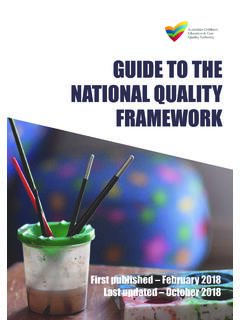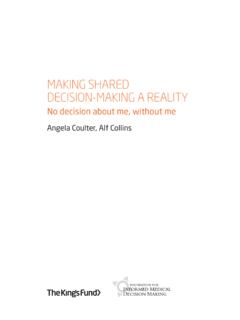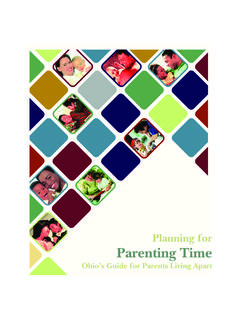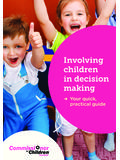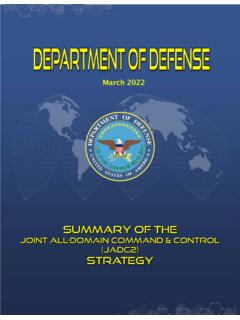Transcription of Sustained, shared thinking - ACECQA
1 NQS PLP e-Newsletter 2012. Sustained, shared thinking Educators are actively engaged in children's learning and share has been highlighted in recent years by findings from international decision making with them. They use everyday interactions with research such as the Effective Provision of Pre-school Education children during play, routines and ongoing projects to stimulate (EPPE) Project in Britain. The EPPE Project, which followed 3000. children's thinking and to enrich their learning children as they moved from preschool to school, identified the ( ACECQA , 2011, p. 124). quality of adult child verbal interactions' as a critical component in effective early childhood programs (Sylva, Melhuish, Sammons, Educators engage in sustained shared conversations with Siraj-Blatchford & Taggart, 2004, p. 5). children to extend their thinking (DEEWR, 2009, p. 15). Researchers on the project coined the term sustained shared thinking ' to describe the kind of interactions that best supported Setting the scene and extended children's learning.
2 The formal definition of sustained, shared thinking is when two or more individuals work As educators, we have a vital role to play in children's learning. together in an intellectual way to solve a problem, clarify a concept Through our interactions with children we provide support, [or] evaluate an activity Both parties must contribute to the encouragement and motivation, as well as information, resources thinking and it must develop and extend the understanding'. and guidance. The Early Years Learning Framework firmly endorses (Sylva et al., 2004, p. 6). play-based learning. It also strongly recognises the significant role that educators play in helping to ensure that children's play and Put more simply: sustained, shared thinking involves children learning is effective and meaningful for them. and educators working together in conversations which provide opportunities to discuss and think about problems or challenges in Recent e-Newsletters have focused on Responding to children's play a serious, extended way.
3 (No. 34) and The importance of relationships (No. 36). In this edition we look at the related topic of Sustained, shared thinking and In everyday reality, many of the conversations that we have with consider how educators, through their interactions with children, children are superficial (a quick hello or passing comment) or can support the development of children's complex thinking and directive (telling them what to do or how to do it). There is a time problem-solving skills. and a place for both of these passing conversations'. But, if that is the limit of our interactions with children, then we have little One of the most important things that we do as educators is to opportunity to connect seriously with children's learning and engage in conversations with children, based on our relationships thinking . Sustained, shared thinking reminds us of the importance with them. The importance of these conversations and interactions of making time for open-ended and exploratory conversations.
4 For us as educators this means not just being involved in children's play, but using this shared experience to take advantage of opportunities to extend and enhance children's thinking . By engaging children in deep conversations about what they are doing; by asking open-ended questions to encourage their thinking ; and by supporting them to reflect on and evaluate the success or otherwise of their efforts, we can help children to begin to think in more sophisticated and abstract ways. Sometimes though, in the busyness of the average day, it can be hard to find the time for such interactions to occur. For many educators, the question is not so much about whether such conversations and interactions are important but rather how can we ensure that they happen on a regular basis? We may need to deliberately plan for such interactions to happen and give them top priority in our schedule. 1. In early childhood settings where meaningful conversations and episodes of sustained, shared thinking occur regularly, specific strategies are usually put in place to ensure that they do happen.
5 Such strategies may include: arranging the daily routine to ensure there are blocks of time in which educators and children can become deeply involved in learning and conversations about learning deliberately making use of routine times as opportunities to engage children in meaningful conversations (see box). planning rosters and staff shift-working arrangements to ensure that as many staff as possible are available to interact with Keeping the ball in the air . children rather than doing other tasks. Sometimes we feel we open-ended questions to extend should share cleaning and other tasks so one person is not over-burdened. This can result in too many staff being off the conversation floor at the same time leaving relatively few adults available A common metaphor for conversation is the idea of a ball' that is to talk with children thrown' back and forth between the participants. The longer the ensuring that educators understand how vital conversational ball can be kept in the air, the deeper and richer the conversation.
6 Interactions are, so that they are more likely to initiate and Skillful educators use open-ended questions to keep the engage in them. Educators in our settings may require specific conversational ball' in the air. Such questions encourage thinking skills in how to ask open-ended questions and other strategies and open up new perspectives. As children talk through ideas and for extending children's thinking questions, new ideas and creative solutions have the chance to emerge. In the process, children not only broaden and extend their thinking about how supervision is managed so that educators understanding of the problem at hand but they also begin to learn can focus on their interactions with individual children or the value of collaborative approaches to problem solving. small groups, rather than feeling that they always need to be monitoring the entire group Conversations that support sustained, shared thinking involve: providing a rich and engaging environment that provokes genuine, open-ended to-and-fro inquiry ideas and encourages conversations in the first place.
7 It's creative and collaborative problem solving hard to have an interesting conversation if there is nothing interesting to talk about! children having the chance to elaborate, recap and review ideas suggesting and wondering scaffolding children's understanding of what is being discussed summarising and reflecting. Some good questions for encouraging and extending such conversations include: What do you think?'. I wonder what would happen if ?'. How do you know?'. How could we find out?'. What else do we need?'. I wonder why ?'. What happened when ?'. Can you tell me more about that?'. What else do you know about ?'. 2. Educator's story Amy Shine, Director, Forbes Preschool At Forbes Preschool we try to take every chance to engage children in conversation. This means deliberately involving ourselves in children's play in order to support children's thinking and learning. It also means making sure that we see all parts of our day as potential learning experiences.
8 We deliberately try not to rush routines such as pack away and mealtimes or walking back from a local excursion. When we involve the children in these routines, they become important teachable moments. At mealtimes, rather than standing and chatting with each other, or issuing orders wash your hands, sit on your chair, put your rubbish in the bin we take every opportunity to engage the children in genuine conversations. Mealtimes provide a great chance to reflect on the day so far, to talk about what we have already done, and to plan for what we might do next. They are also a chance to develop relationships and share information with each other. Listen in at morning tea and you might hear an educator telling the children that she lives on a citrus farm and that her husband picked the oranges that are in the fruit bowls on the tables; or you might observe another educator cooking toast for a child who didn't have time for breakfast, all the while chatting about what she, as an adult, likes to eat at breakfast time.
9 Throughout the day educators and children share real-life conversations conversations that provide us with opportunities to extend children's thinking as well as to share something about our lives outside the setting. Genuine conversations not only involve us learning about our children and families but also provide opportunities for them to learn about us. We believe that conversations are vital for building trusting relationships relationships that lay the foundations for effective and meaningful learning. How to draw a mirror sustained, shared thinking in action As part of a longer-term project that involved turning a cardboard box into a car, one group of children set themselves the task of making the car's mirrors. At first, it seemed simple, but as they started work it quickly became apparent that a mirror is actually a very difficult thing to draw. How do you capture the changing nature of reflection in a static image? It took most of the morning, plenty of animated discussion, and many trips to the bathroom to look at actual mirrors to arrive at an acceptable solution.
10 As an example of sustained, shared thinking in action, it highlighted how important ongoing discussion, experimentation and reflection are, not just for effective problem solving, but also for the process of carefully thinking through a problem in order to arrive at a considered solution, rather than simply grabbing at the first possible solution. As the morning progressed, the children discussed and tried various ways of representing a mirror. Much of this discussion was self-generated but, as the educator with the group, I took the role of following what was going on and asking questions that either extended children's thinking or helped to break a deadlock when they were stuck. Without the pressure of time or the need to come up with an instant solution, we could explore questions such as: what does a mirror do?' and how does a mirror work?'. At one point the children were leaning towards finding something reflective to cover the mirror pieces with.




